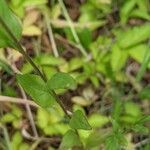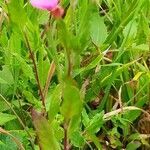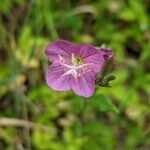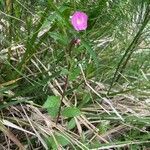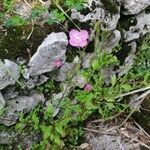Herbs ascending to decumbent, perennial, rhizomatous and sometimes suffrutescent from woody caudex, rarely with basal rosette. Stems 7-65 cm, simple or branched, strigillose, sometimes with longer spreading hairs. Leaves green, with inconspicuous veins, glabrous to sparsely strigillose; petioles 3-20 mm; basal blade 2-5 × 0.5-2 cm; cauline blade elliptic to oblanceolate or oblong-ovate, 1-6 × 0.4-2.5 cm, base attenuate, margin subentire to coarsely dentate, sometimes sinuate-pinnatifid at leaf base, apex acute to obtuse. Inflorescence a lax open simple raceme. Flowers open near sunrise; floral tube 4-10 mm. Sepals 5-10 mm, with free tips 0.4-1 mm. Petals pink to rose-purple, 5-12 mm. Anthers 2-3.5 mm; pollen ca. 50% fertile. Ovary usually densely strigillose; stigma surrounded by anthers. Capsules clavate or narrowly obovoid, 4-12 mm, valves angled or weakly winged, attenuate to slender sterile stipe (pedicel) 5-20 mm. Seeds in several indistinct rows per locule, brown with dark spot at each end, obovoid, 0.5-1.2 mm, finely papillose. Fl. May-Nov, fr. Jun-Dec. 2n = 14, permanent translocation heterozygote; self-compatible, autogamous.
Perennial herb, often blooming the first year, with numerous stems commonly 20-50 cm. tall from a somewhat woody caudex. Plants strigulose throughout, more densely so in the inflorescence. Leaves 2-5 cm. long, oblanceolate to narrowly obovate, entire to somewhat pinnatifid at the base of the blade, acute, the base narrowly cuneate; petioles 0.4-3 cm. long, distinct. Inflorescence nodding before anthesis, the flowers up to c. 1 cm. long, borne in the axils of much reduced leaves. Flowers opening near sunrise. Floral tube 3.5-6.5 mm long, slender. Sepals 5-8 mm long, commonly coherent and deflexed to one side in anthesis. Petals 4.5-8 mm long, bright purplish-rose. Anthers 2.5-4 mm long, on slender filaments 4-6 mm long. Style surrounded by the anthers at anthesis; stigma c. 2 mm long, with linear lobes. Capsule clavate, 8-10 x 3-4 mm, strigulose, narrowly winged, the base passing gradually into a hollow, ribbed stipe 5-20 mm long. Seeds c. 0-6 mm long, brown, oblong-ovoid, in 2 rows in each locule.
Short-lived perennial or biennial, taprooted herb with rather sprawling, branched habit. Stems to c. 50 cm long, very slender, strigillose, reddish. Basal rosette lacking. Lower cauline lvs glabrate or somewhat strigillose, sometimes glabrous above; petiole to c. 3 cm long, slender; lamina 1.5-4 × 0.5-1.6 cm, lanceolate to elliptic, somewhat pinnatifid towards base, otherwise denticulate; base cuneate to attenuate; apex acute; uppermost lvs becoming ± apetiolate, smaller, and often subentire. Fls few, distant, diurnal; pedicels filiform, strigillose. Floral tube 3-6 mm long, densely strigillose. Buds ovoid, erect. Sepals 7-9 mm long, with reddish hairs as on floral tube; apices erect in bud. Petals c. 6-8 mm long, broad-obovate, rose. Style exserted by c. 5-9 mm, glabrous, = or slightly < filaments. Capsule c. 8 mm long (probably all immature), obovoid or broad-clavate, ribbed, densely strigillose, shortly tapering to base. Seeds c. 0.75 mm long, oblong to ellipsoid, not angled.
Weedy perennial, 0.20-0.25 m high; many stems from a woody caudex; strigillose throughout. Leaves alternate, ± oblanceolate, entire to pinnatifid at base of blade, base cuneate, apex acute; petioles up to 30 mm long. Flowers borne in axils of reduced leaves, opening near sunrise, diurnal. Floral tube up to 8 mm long, slender. Sepals deflexed to one side in anthesis. Petals up to 10 mm long, rose-purple. Flowering time Sept.-Apr. Fruit a capsule, up to 10 x 4 mm, narrowly winged, base fitting into hollow, ribbed stipe. Seeds oblong-ovoid.
Perennial herb, 200-500 mm high, mostly strigulose. Stems erect. Leaves petiolate; blade narrowly obovate, 20-50 mm long, margins entire to somewhat pinnatifid at base; petioles 4-30 mm long. Flowers: < 20 mm in diameter; floral tube 4-8 mm long; sepals 5-8 mm long; petals 5-10 mm long, bright purplish rose; Sep.-Apr. Fruit clavate, 8-10 mm long.
Leaves 2–5 cm. long, oblanceolate to narrowly obovate, entire to somewhat pinnatifid at the base of the blade, acute, the base narrowly cuneate; petioles 0·4–3 cm. long, distinct.
Perennial herb, 200-500 mm tall, mostly strigulose. Capsule clavate. Flowers opening near sunrise; less than 20 mm in diameter; bright purplish rose.
Capsule clavate, 8–10 × 3–4 mm., strigulose, narrowly winged, the base passing gradually into a hollow, ribbed stipe 5–20 mm. long.
Perennial herb, often blooming the first year, with numerous stems commonly 20–50 cm. tall from a somewhat woody caudex.
Inflorescence nodding before anthesis, the flowers up to c. 1 cm. long, borne in the axils of much reduced leaves.
Style surrounded by the anthers at anthesis; stigma c. 2 mm. long, with linear lobes.
Sepals 5–8 mm. long, commonly coherent and deflexed to one side in anthesis.
Seeds c. 0·6 mm. long, brown, oblong-ovoid, in 2 rows in each locule.
Plants strigulose throughout, more densely so in the inflorescence.
Anthers 2·5–4 mm. long, on slender filaments 4–6 mm. long.
Petals 4·5–8 mm. long, bright purplish-rose.
Floral tube 3·5–6·5 mm. long, slender.
Flowers opening near sunrise.
Autogamous.
